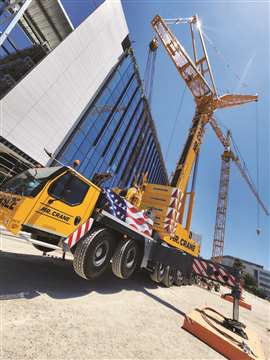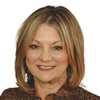Mastering tower crane services: a guide to this specialized field
14 August 2024
Tower crane services is a specialty sector of the crane market that requires expert knowledge, specific know-how and up-to-date training. It has become a competitive niche market in North America.
 A range of cranes can be used to erect, climb and dismantle tower cranes, typically anything from a 135- to 600-ton all-terrain crane to 40- to 50-ton assist cranes.
A range of cranes can be used to erect, climb and dismantle tower cranes, typically anything from a 135- to 600-ton all-terrain crane to 40- to 50-ton assist cranes.
“The tower crane market in the Pacific Northwest has always been a thriving and ever-growing market,” said John Anderson, president of NessCampbell Crane + Rigging, based in Hillsboro, OR. NessCampbell and other companies in this sector provide a range of services – including erection, climbing and dismantle services. Turnkey packages include erection, operator, climbing, monthly and yearly maintenance, recertification and dismantle. Companies like NessCampbell can also provide any necessary rigging, lights, radios and the like to fully meet the needs of tower crane providers.
“Tower cranes are generally the ‘thermometer’ of the construction industry,” said Selwyn Rabbits of Mr. Crane, based in Orange, CA. “The more tower cranes in the air, the healthier the construction environment. Tower cranes provide a solid and reliable revenue stream as the projects normally run for 12 months or more. Do it well, and good relationships are developed. It complements our mobile/crawler crane operations well, smoothing out the work.”
In addition to turnkey packages, other services involve assisting the client with lifting requirements, identifying suitable cranes and their location, providing crane crews and supervising their operations, assisting the client with safety regimes, crane maintenance and providing advice on special lift requirements.
A range of cranes can be used to erect, climb and dismantle tower cranes.
 Turnkey tower crane services packages include erection, operator, climbing, monthly and yearly maintenance, recertification and dismantle.
Turnkey tower crane services packages include erection, operator, climbing, monthly and yearly maintenance, recertification and dismantle.
“Typically, anything from our 135-ton Liebherr AT for the smaller tower crane projects, up to our 600-ton Liebherr AT with mega-wing and luffing jib for the taller and more complex projects,” said Anderson.
Support player
“We generally use 200-ton or larger mobile cranes to erect and dismantle the tower cranes, although, on occasion, we have used 300-ton plus crawler cranes,” said Rabbits. “We generally use a 40- to 50-ton mobile crane to assist.”
How do companies get into this sector of the crane business?
“For years all we did was provide just the mobile crane to support this type of work,” said Anderson. “As our company grew, our customers were looking for better options – a company that could provide these services under one roof. So we organized and hired the appropriate personnel and started down the path of providing full-service tower crane service packages.”
In 2003, Mr. Crane saw an opening in the market to provide complete tower crane packages, Rabbits said.
“This was part of our move to expand our revenue base and reduce our reliance on tilt-panel work,” he said. “A project manager of ours had previous experience with tower cranes and was able to help us break into the market.”
 The more tower cranes in the air, the healthier the construction environment.
The more tower cranes in the air, the healthier the construction environment.
This work requires specialized knowledge and skill, Anderson said.
“We employ the use of our highly trained union Iron Workers and Union Operating Engineers to perform all aspects of tower crane work,” said Anderson. “With the support of our top-tier safety department and engineering team, we can handle any project that is put in front of us.”
Initially, Mr. Crane primarily sourced its tower cranes from Morrow Equipment, which provided great technical and engineering support, Rabbits said.
“Gradually, we built up experience in our rigging crews for tower crane erection and climbing,” he said. “We hired a good team of experienced tower crane operators.
Inspections and maintenance
Once a tower crane is erected, it still requires routine inspections and maintenance.
“The cranes are inspected multiple times after the erection and throughout the duration of the project,” said Rabbits. “Once the crane is erected, it has an initial third-party inspection followed by the initial OSHA inspection. After it has been in the air for 40 hours, all the bolts are retorqued and inspected by the crew, who complete the retorque. It is then inspected by Cal OSHA at six months and then annually by a third-party and Cal OSHA.”
Inspection regulations differ from region to region, and state to state.
 The more tower cranes in the air, the healthier the construction environment.
The more tower cranes in the air, the healthier the construction environment.
“We offer services that include providing our customers with a fully NCCCO-certified and accredited tower crane operators for any scope needed from self erectors to flat top, hammer head and luffing boom cranes,” Anderson said. “Our operators come backed with additional education and training programs offered in-house at NessCampbell and NessCampbell University.”
Rabbits said Mr. Crane provides expert planning and advice to its clients.
“We provide good/reliable equipment, do what we say we are going to do, have excellent tower crane operators and take on the tough jobs,” he said.
Understanding and staying on top of regulatory changes is very important, Anderson and Rabbits agreed.
“We are always looking for safer and more efficient means and methods to continue to be leaders in the industry,” said Anderson. “One very important factor in all of this is to maintain and promote the training and continuing education of our team members so that everyone is successful and goes home safe and healthy every day.”





